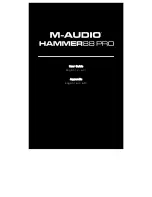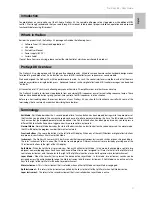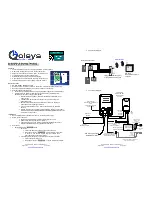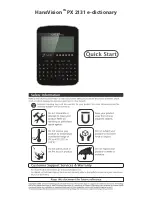
Program mode: HD-1
106
Event:
The phrase or pattern will be advanced by one
note or one chord, ignoring the rhythm of the phrase or
pattern. Each trigger will produce the next note or
chord in the phrase.
Chord Trigger Mode
[Off, 1st, Chord1,
Chord2, Chord3]
This is valid when “Mode” is
Dyn, Auto + Dyn1
or
Auto + Dyn2
. It specifies how a chord will be sounded
when that chord is input from the keyboard.
Off:
There will be no sound when you input a chord
from the keyboard. This is analogous to a guitarist
changing chords in the left hand. The phrase or pattern
will sound from the first step when you operate the
controller.
1st:
When you input a chord from the keyboard, the
first step of the phrase or pattern will sound. When
you operate the controller, the phrase or pattern will
continue advancing.
Chord1:
When you input a chord from the keyboard,
the first several steps of the phrase or pattern will
sound, according to the number of notes that you
input. When you operate the controller, the phrase or
pattern will continue advancing.
Chord2:
When you input a chord from the keyboard, it
will sound in the same way as for Chord1. However,
the phrase or pattern will play from the beginning of
the pattern when you operate the controller.
Chord3:
When you input a chord from the keyboard, it
will sound in the same way as for Chord1. However,
the phrase or pattern will start from the second step
when you operate the controller. When simulating
acoustic guitar finger picking, this allows you to create
a natural connection between the played chord and the
finger picking sounded by the controller.
Velocity Sense Bottom
[001…127]
This is valid when “Mode” is
Dyn, Auto + Dyn1 or
Auto + Dyn2
. If the Dynamic MIDI
Source
is
Note
or
Velocity
, the phrase will be produced by applying the
velocity of each Manual Advance trigger that is input
to the KARMA Module to the notes as they are
generated. This parameter specifies the lower limit of a
scaled range that the velocity is adjusted by before
being applied.
With a setting of
001
, the velocity data will be input to
the KARMA Module with an unmodified range of 1–
127 (full sensitivity).
With a setting of
064
, velocity data in the range of 1–
127 will be scaled to the range of 64–127 before it is
input to the KARMA Module (half sensitivity).
Note Map
The Note Map Parameters allow a “final note shaper”
to be applied at the end of the KARMA note generation
process. Implemented as a large grid (128 x 129), it
allows any incoming MIDI note generated by KARMA
(0-127) to be remapped to any other MIDI note (0-127),
or filtered out (removed). Therefore, a diagonal line
represents “linear/no change,” and what goes in is
what comes out.
You can use it to remap drum kits from one set of drum
sounds to another, remove or substitute different drum
sounds within the same kit, remove certain pitches
from melodic output, constrain output pitches to
various scales, limit notes generated thru Melodic
Repeat to certain pitches, and more. For more
information, see “Repeat (Melodic Repeat) Group” on
page 939.
Each program, combination, or song contains a single
user table. named “Custom. “ The settings of this
single table are stored inside the program,
combination, or song. Additionally, there are a number
of tables stored in global memory, with pre-defined
functions, that can be selected for use by any Module.
The same table can be applied to multiple Modules at
the same time. All Modules can run through the single
Custom table at the same time, or be assigned to utilize
various Global Note Maps, in any combination.
Mode (Note Map Mode)
[Off, On-Main,
On-Repeat, On-All]
Selects one of several different modes of operation,
controlling whether all notes generated by KARMA or
a subset of those notes are modified by the specified
Note Map Table.
Off:
The table is inactive and no filtering or remapping
is done.
On-Main:
The table is used to map or filter notes being
generated from the Note Series or Drum Pattern(s), but
not any notes generated as a result of the Melodic
Repeat parameters.
On-Repeat:
The table is used to map or filter notes
being generated as a result of the Melodic Repeat
parameters, but not the main notes generated by the
Note Series or Drum Pattern(s). For example, this can
be used to “thin out” repeats or limit “strange notes” in
Drum Patterns from transposed repeats, without
affecting the main notes.
For more information, see “Repeat (Melodic Repeat)
Group” on page 939.
On-All:
The table is used to map or filter all notes
being generated by the module.
Table (Note Map Table)
[Custom,
Gtable 1…Gtable 64]
Selects the Custom table (user table) or one of the
Global Note Map Tables.
Note:
You can edit a custom table in Program 7–9:
Name/Note Map. (See “7–9c: Note Map” on page 121.)
Transpose (Note Map Transpose)
[–12…+12]
This allows you to set up a “Fixed” Note Transpose
Map, without “Chord Track” or “Keyboard Track (C2
Ref),” and then apply an offset to transpose it to other
keys. In other words, you can set up a fixed map so
that no matter what you play, it comes out in C
Mixolydian. Then, you can set the Note Map Transpose
to +2 , and it would be D Mixolydian, etc.
The “Transpose” parameter is only available when
“Chord Track” is Off (unchecked).
Содержание Electronic Keyboard
Страница 1: ...Parameter Guide Parameter Guide ...
Страница 2: ......
Страница 180: ...Program mode EXi 170 ...
Страница 290: ...EXi STR 1 Plucked String 280 ...
Страница 572: ...Sequencer mode 562 ...
Страница 700: ...Global mode 690 ...
Страница 751: ...Insert Effects IFX1 IFX12 Routing 741 Fig 2 3a Fig 2 3b ...
Страница 902: ...Effect Guide 892 ...
















































